The boom of fintechs and the rapid turn towards digitalization in Latin America has driven a strong growth of the digital payment ecosystem in the region. And with it, QR code payments have established themselves as one of the most essential services for both consumers and businesses on the continent.
In Brazil, for example, data from the Central Bank indicates that at least three out of ten Brazilians have already made payments via QR codes. The Brazilian Central Bank has developed several initiatives to support the financial and commerce sectors in the last two years. The development of the famous PIX and the advance in the transition towards Open Banking were some of them, and thanks to this, today, more and more Brazilians have access to a digital financial life.
Another example in the region is the Central Bank of Argentina, which has been pushing an interoperable, open, and universal digital system, which has motivated many actors to join the scheme.
In Colombia, something similar has been happening, where the local bank is working and finalizing details to achieve a payment ecosystem with the same characteristics as its South American counterparts.
Democratizing access to banking in LatAm
For Bruno Martucci, Head of Product at Pomelo, the widespread use of QR Codes democratizes banking on the continent.
“In Latin America, although there is no system like PIX instantaneous funds transfer, there are companies that make QR Codes available so that their clients can make sales and purchases by this means. The QR Code has become a potent banking tool for a straightforward reason: it does not require sophisticated equipment. With a simple digital account, you can make payments and send money or make a sale and receive the money,” Martucci said in an interview with Fintech Nexus.
For him, the advance in regulating these systems has made creating digital accounts a broader, more transparent, and flexible process, allowing more people to access these products and be financially included.
A growing number of non-cash payments
A survey by the consultancy PwC indicates that the number of transactions with non-cash payment methods will grow 52% by 2025 in Latin America and then 48% by 2030.
Multinational payment and e-commerce companies are benefiting from this growth process as well. Mercado Pago, for example, recorded at least 112.8 million payments with the QR system in Latin America in the second half of 2022, a figure that represents 148% growth compared to the same period in 2021.
Related links:
With the arrival of fintechs with similar services in other parts of the region, countries where the Brazilian PIX is not yet present, such as Colombia and Chile, have already been able to devote more significant efforts to the experience with this type of payment. In Colombia, the fintech ecosystem will have access to a system with interoperability in the coming years, while Chile is applying this type of payment by QR Code in public transport.
According to a Banco de la República study, Argentina registered $15.4 billion in digital payments since 2020, with 25 million users.
Meanwhile, payments reached a total of $8.5 billion in Chile, with 11 million users. Also, there were $8,200 million in transactions in Colombia, achieved by 22 million people.
And Brazil is the country that has registered the most annual digital payments, with $51.4 billion in transactions from at least 105 million users.
New level of development

“We understand that in the last two years, there was a fairly great pent-up demand for a payment method that was efficient in terms of time and cost, that democratized financial exchanges a little bit for the population,” Vinícius Vieira, Head of Business Development at BEXS, told Fintech Nexus.
For Vieira, in the corporate world, the old interbank system met the medium-term needs of companies. Still, the infrastructure was prohibitive regarding facilitating exchanges between people and companies and automating online consumption processes from available account balances. However, for him, the radical change in payment methods will now enable a new level of development in LatAm and the world.
“Instant payments and interoperability has become an inevitable movement [in Latin America] and is inherent to the digital transformation of all aspects of life. I do not doubt we will see this more and more,” Vinicius Vieira commented.


